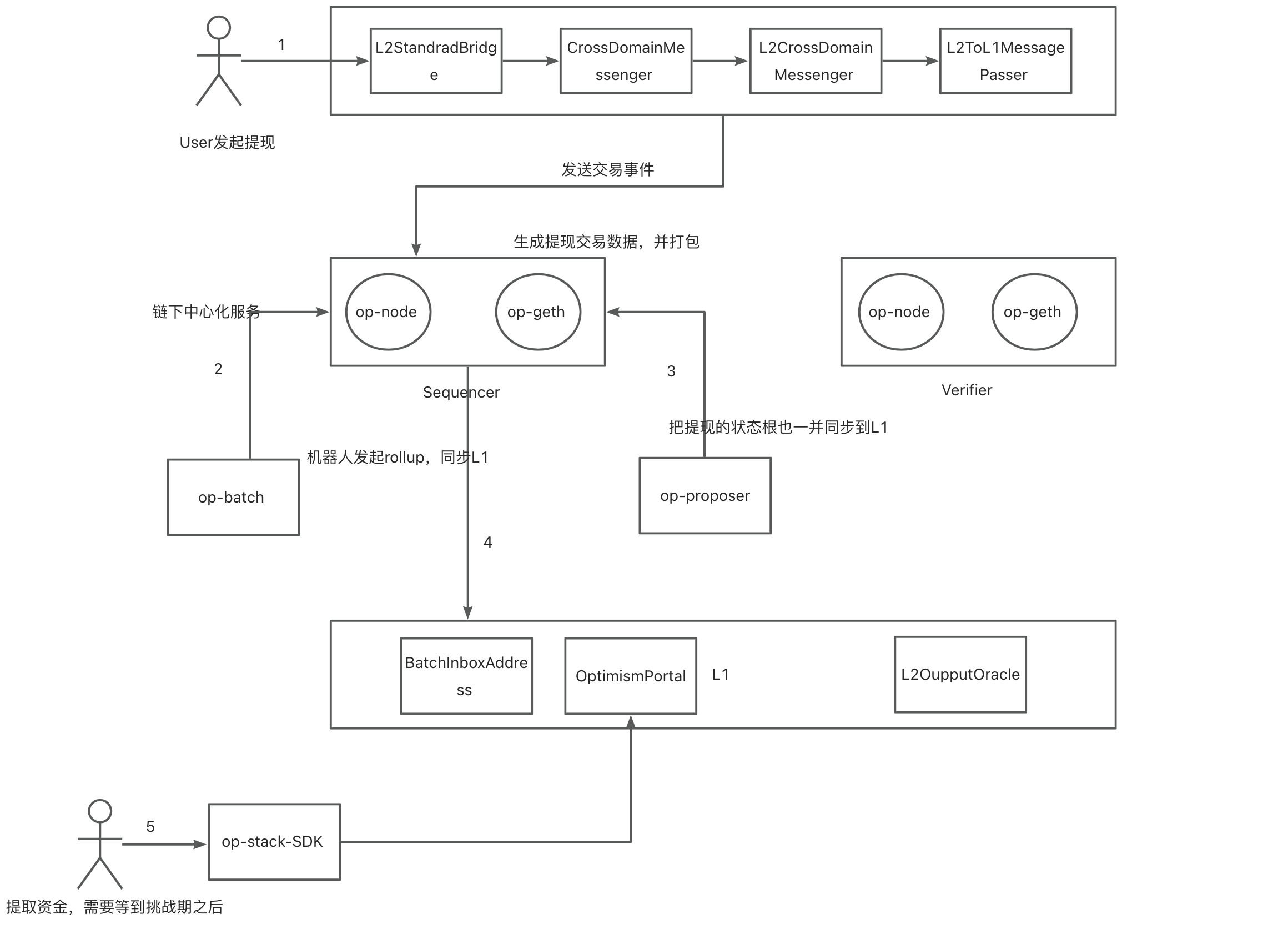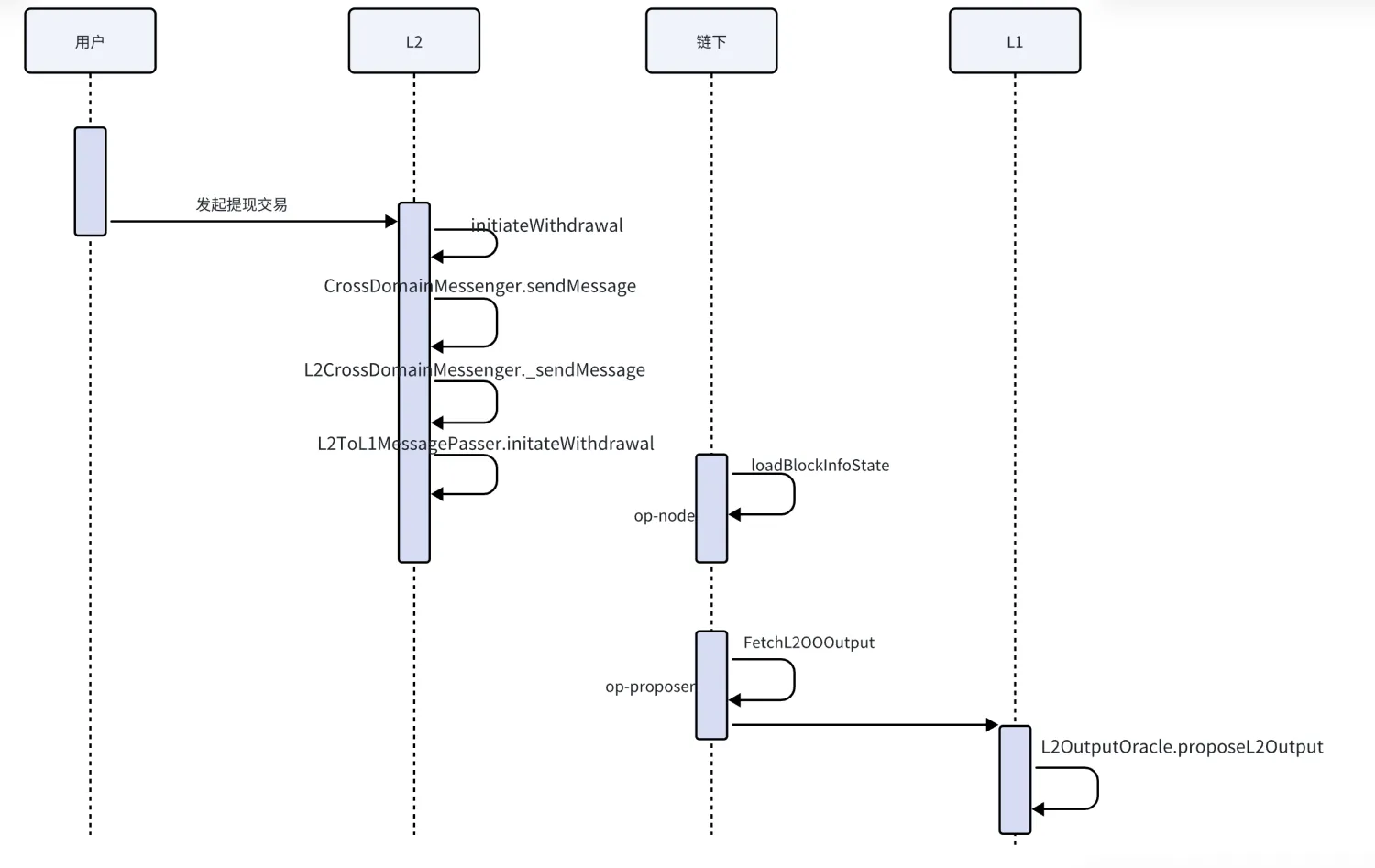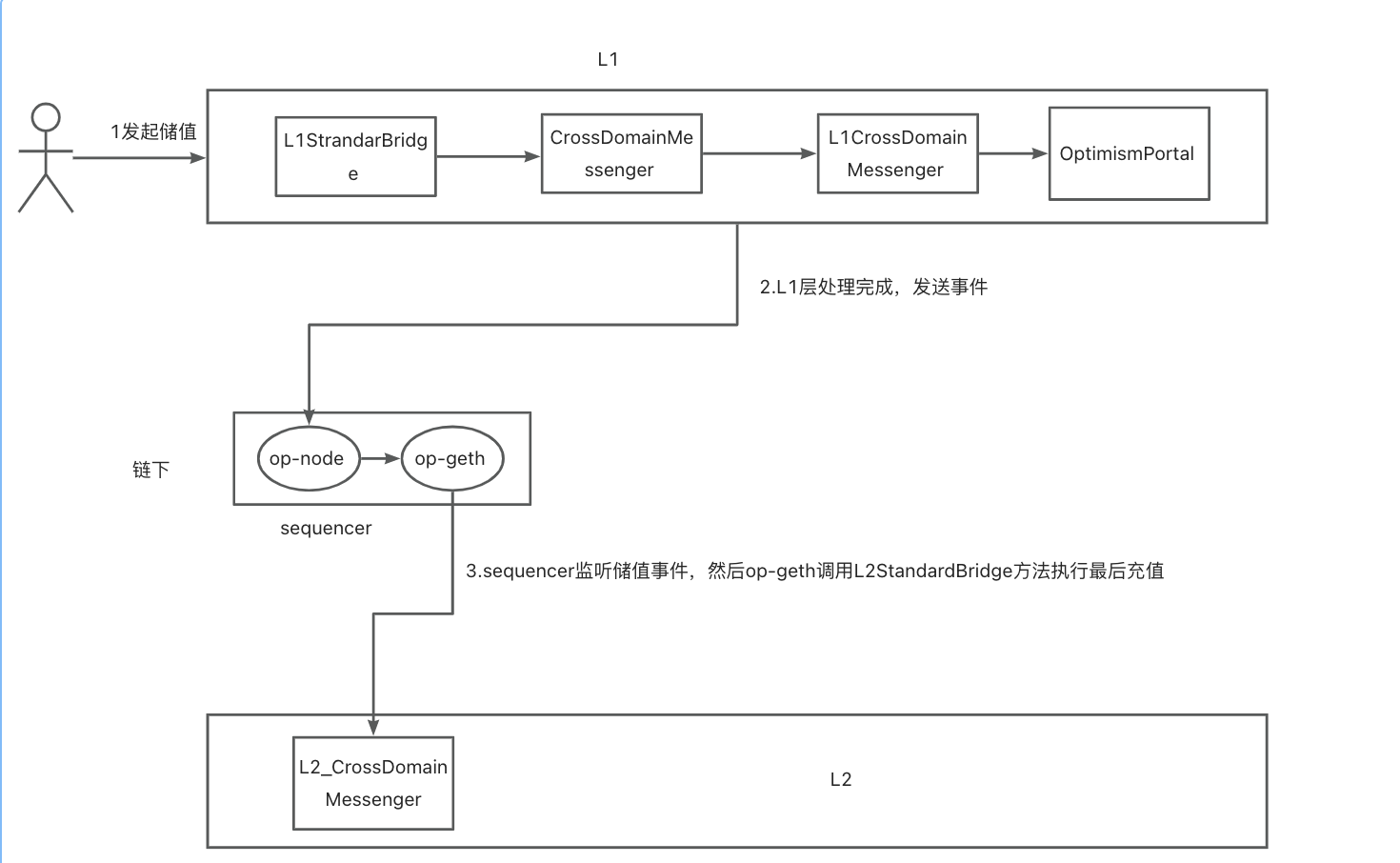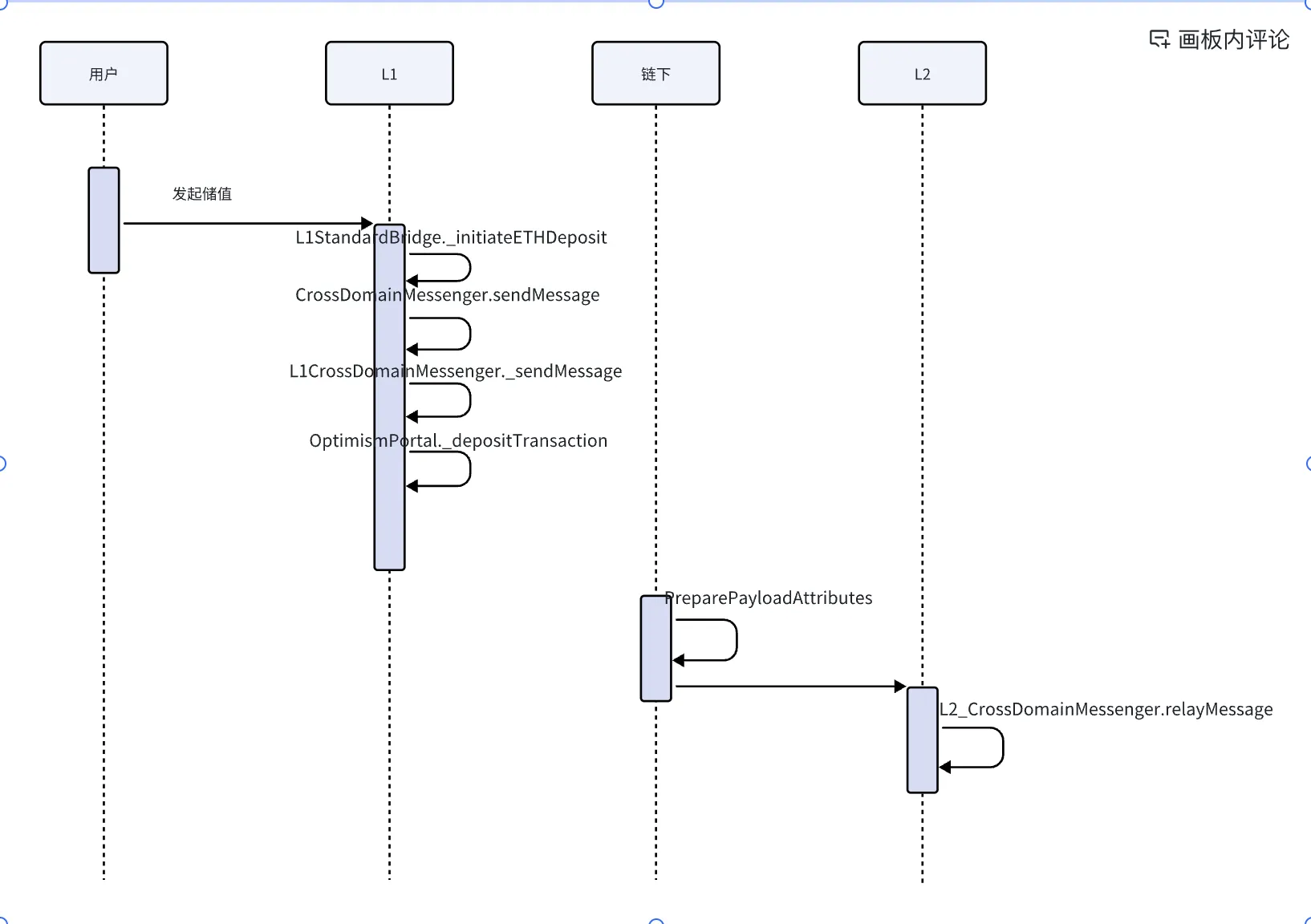深入OpStack,提现,储值的处理逻辑
- Leo
- 发布于 2024-09-26 00:38
- 阅读 2741
opStack各个角色op-node负责和op-geth交易打包落块,交易状态推导,数据传输同步的客户端batcher将数据同步到L1的EOA账户op-processer提交区块状态到L1的L2OutputOracle合约crossDomainMessagener跨
opStack 各个角色
op-node 负责和op-geth交易打包落块,交易状态推导,数据传输同步的客户端 batcher 将数据同步到L1的EOA账户 op-processer 提交区块状态到 L1 的 L2OutputOracle 合约 crossDomainMessagener 跨链信使合约,负责L1->L2,L2->L1的通信 OptimismPortal 是 op-stack 的充值提现纽带合约 Bridges 桥合约,主要功能是承载充值提现 L2OutputOracle 在L1层接收L2过来的状态根的合约
L2->L1 提现逻辑

提现的核心步骤
第一步 用户在L2层调用withdraw给自己地址提币 第二步 业务逻辑在L2合约层进行处理,中间会经过以下几个合约和步骤 1.首先会在L2StandradBridge上面执行call_initiateWithdrawal。根据ETH/ERC20 2.如果提现的是ETH,则会调用CrossDomainMessenger的sendMessage方法,将msgNonce+1,并在方法体内部调用L2CrossDomainMessenger的_sendMessage方法 3.L2CrossDomainMessenger的_sendMessage 会调用L2ToL1MessagePasser的initateWithdrawal。构造出withdrawalHash,并维护msgNonce自增为1。完事发送事件 第三步 sequencer中的op-node 监听到交易事件,将事件打包成交易 (此步在链下处理) 第四步 Op-batch负责发打包好的交易rollup到L1里面,Op-proposer负责将这批次的状态根stateroot提交到L1 第五步 用户在L1提取资金(但是要注意的是,需要在挑战期过后才能提取),可以使用op-stack-SDK。它内部的逻辑会调用L1层的OptimismPortal来提取资金。
L2链层源码
function _initiateWithdrawal(
address _l2Token,
address _from,
address _to,
uint256 _amount,
uint32 _minGasLimit,
bytes memory _extraData
)
internal
{
if (_l2Token == Predeploys.LEGACY_ERC20_ETH) { // 判断是否是ETH
_initiateBridgeETH(_from, _to, _amount, _minGasLimit, _extraData);
} else {
address l1Token = OptimismMintableERC20(_l2Token).l1Token(); //属于ERC20
_initiateBridgeERC20(_l2Token, l1Token, _from, _to, _amount, _minGasLimit, _extraData);
}
}执行父类的方法,_initiateBridgeETH
function _initiateBridgeETH(
address _from,
address _to,
uint256 _amount,
uint32 _minGasLimit,
bytes memory _extraData
)
internal
{
require(isCustomGasToken() == false, "StandardBridge: cannot bridge ETH with custom gas token");
require(msg.value == _amount, "StandardBridge: bridging ETH must include sufficient ETH value");
_emitETHBridgeInitiated(_from, _to, _amount, _extraData);
messenger.sendMessage{ value: _amount }({
_target: address(otherBridge),
_message: abi.encodeWithSelector(this.finalizeBridgeETH.selector, _from, _to, _amount, _extraData),
_minGasLimit: _minGasLimit
});
}此时,方法进入到CrossDomainMessenger
function sendMessage(address _target, bytes calldata _message, uint32 _minGasLimit) external payable {
if (isCustomGasToken()) {
require(msg.value == 0, "CrossDomainMessenger: cannot send value with custom gas token");
}
_sendMessage({
_to: address(otherMessenger),
_gasLimit: baseGas(_message, _minGasLimit),
_value: msg.value,
_data: abi.encodeWithSelector(
this.relayMessage.selector, messageNonce(), msg.sender, _target, msg.value, _minGasLimit, _message
)
});
emit SentMessage(_target, msg.sender, _message, messageNonce(), _minGasLimit);
emit SentMessageExtension1(msg.sender, msg.value);
unchecked {
++msgNonce;
}
}在调用_sendMessage 的时候,执行的是子类的_sendMessage
function _sendMessage(address _to, uint64 _gasLimit, uint256 _value, bytes memory _data) internal override {
IL2ToL1MessagePasser(payable(Predeploys.L2_TO_L1_MESSAGE_PASSER)).initiateWithdrawal{ value: _value }(
_to, _gasLimit, _data
);
}最终执行的是L2ToL1MessagePasser,逻辑是将执行交易的参数打包成hash,并发送事件,到这里,L2层的逻辑已经执行完毕。
function initiateWithdrawal(address _target, uint256 _gasLimit, bytes memory _data) public payable {
bytes32 withdrawalHash = Hashing.hashWithdrawal(
Types.WithdrawalTransaction({
nonce: messageNonce(),
sender: msg.sender,
target: _target,
value: msg.value,
gasLimit: _gasLimit,
data: _data
})
);
sentMessages[withdrawalHash] = true;
emit MessagePassed(messageNonce(), msg.sender, _target, msg.value, _gasLimit, _data, withdrawalHash);
unchecked {
++msgNonce;
}
}链下执行逻辑
func (l *BatchSubmitter) loadBlocksIntoState(ctx context.Context) error {
// 获取并判断需要提交的最新 L2 的 start 和 end 块号
start, end, err := l.calculateL2BlockRangeToStore(ctx)
if err != nil {
l.Log.Warn("Error calculating L2 block range", "err", err)
return err
} else if start.Number >= end.Number {
return errors.New("start number is >= end number")
}
var latestBlock *types.Block
// 从起始区块开始获取区块信息,并将区块加到 channelManager 的 blocks
for i := start.Number + 1; i < end.Number+1; i++ {
//核心逻辑就是 l.loadBlockIntoState
block, err := l.loadBlockIntoState(ctx, i)
if errors.Is(err, ErrReorg) {
l.Log.Warn("Found L2 reorg", "block_number", i)
l.lastStoredBlock = eth.BlockID{}
return err
} else if err != nil {
l.Log.Warn("Failed to load block into state", "err", err)
return err
}
l.lastStoredBlock = eth.ToBlockID(block)
latestBlock = block
}
// 提取基本的 L2BlockRef 信息
l2ref, err := derive.L2BlockToBlockRef(l.RollupConfig, latestBlock)
if err != nil {
l.Log.Warn("Invalid L2 block loaded into state", "err", err)
return err
}
// 将L2BlockRef 加载到当前状态根中
l.Metr.RecordL2BlocksLoaded(l2ref)
return nil
}func (l *BatchSubmitter) publishTxToL1(ctx context.Context, queue *txmgr.Queue[txRef], receiptsCh chan txmgr.TxReceipt[txRef], daGroup *errgroup.Group) error {
// 获取当前 Layer 1 的最新区块(tip)
l1tip, err := l.l1Tip(ctx)
if err != nil {
l.Log.Error("Failed to query L1 tip", "err", err)
return err
}
// 记录当前的 l1tip
l.recordL1Tip(l1tip)
// 从状态中获取与当前 L1 tip 相关的交易数据。这一步比较关键,来看一下逻辑
txdata, err := l.state.TxData(l1tip.ID())
if err == io.EOF {
l.Log.Trace("No transaction data available")
return err
} else if err != nil {
l.Log.Error("Unable to get tx data", "err", err)
return err
}
// 发送交易数据到L1
if err = l.sendTransaction(txdata, queue, receiptsCh, daGroup); err != nil {
return fmt.Errorf("BatchSubmitter.sendTransaction failed: %w", err)
}
return nil
}获取与当前L1 tip 相关的交易数据
func (s *channelManager) TxData(l1Head eth.BlockID) (txData, error) {
s.mu.Lock()
defer s.mu.Unlock()
// 上面的代码逻辑是设置互斥锁
var firstWithTxData *channel
// 寻找第一个包含交易数据的通道
for _, ch := range s.channelQueue {
if ch.HasTxData() {
firstWithTxData = ch
break
}
}
dataPending := firstWithTxData != nil && firstWithTxData.HasTxData()
s.log.Debug("Requested tx data", "l1Head", l1Head, "txdata_pending", dataPending, "blocks_pending", len(s.blocks))
// 存在待处理数据或达成短路条件,则调用 nextTxData(firstWithTxData) 返回该通道的交易数据
if dataPending || s.closed {
return s.nextTxData(firstWithTxData)
}
// 没有待处理数据,我们可以添加一个新块到channel,同时返回一个EOF
if len(s.blocks) == 0 {
return txData{}, io.EOF
}
// 确保当前有足够的空间处理新块
if err := s.ensureChannelWithSpace(l1Head); err != nil {
return txData{}, err
}
// 处理待处理的块
if err := s.processBlocks(); err != nil {
return txData{}, err
}
// 处理完所有待处理的块后,注册当前的 L1 头
s.registerL1Block(l1Head)
// 将处理后的数据输出
if err := s.outputFrames(); err != nil {
return txData{}, err
}
// 返回当前通道的交易数据
return s.nextTxData(s.currentChannel)
}op-proposer 逻辑,发送状态根
func (l *L2OutputSubmitter) FetchL2OOOutput(ctx context.Context) (*eth.OutputResponse, bool, error) {
if l.l2ooContract == nil {
return nil, false, fmt.Errorf("L2OutputOracle contract not set, cannot fetch next output info")
}
cCtx, cancel := context.WithTimeout(ctx, l.Cfg.NetworkTimeout)
defer cancel()
callOpts := &bind.CallOpts{
From: l.Txmgr.From(),
Context: cCtx,
}
// 获取下一个检查点的区块号
nextCheckpointBlockBig, err := l.l2ooContract.NextBlockNumber(callOpts)
if err != nil {
return nil, false, fmt.Errorf("querying next block number: %w", err)
}
nextCheckpointBlock := nextCheckpointBlockBig.Uint64()
// 方法获取当前区块号
currentBlockNumber, err := l.FetchCurrentBlockNumber(ctx)
if err != nil {
return nil, false, err
}
// 对比当前区块号和下一个检查点的区块号,确保不会在未来的时间提交区块
if currentBlockNumber < nextCheckpointBlock {
l.Log.Debug("Proposer submission interval has not elapsed", "currentBlockNumber", currentBlockNumber, "nextBlockNumber", nextCheckpointBlock)
return nil, false, nil
}
//使用下一个检查点的区块号来获取输出信息
output, err := l.FetchOutput(ctx, nextCheckpointBlock)
if err != nil {
return nil, false, fmt.Errorf("fetching output: %w", err)
}
// 检查输出信息的区块引用是否大于最终化的 L2 状态的区块号,且是否允许非最终化的状态
if output.BlockRef.Number > output.Status.FinalizedL2.Number && (!l.Cfg.AllowNonFinalized || output.BlockRef.Number > output.Status.SafeL2.Number) {
l.Log.Debug("Not proposing yet, L2 block is not ready for proposal",
"l2_proposal", output.BlockRef,
"l2_safe", output.Status.SafeL2,
"l2_finalized", output.Status.FinalizedL2,
"allow_non_finalized", l.Cfg.AllowNonFinalized)
return output, false, nil
}
return output, true, nil
}func (l *L2OutputSubmitter) proposeOutput(ctx context.Context, output *eth.OutputResponse) {
cCtx, cancel := context.WithTimeout(ctx, 10*time.Minute)
defer cancel()
// 如果上述的检查结果为true,则直接提交状态根transaction
if err := l.sendTransaction(cCtx, output); err != nil {
l.Log.Error("Failed to send proposal transaction",
"err", err,
"l1blocknum", output.Status.CurrentL1.Number,
"l1blockhash", output.Status.CurrentL1.Hash,
"l1head", output.Status.HeadL1.Number)
return
}
l.Metr.RecordL2BlocksProposed(output.BlockRef)
}至此,链下部分也已经处理完成
L1层的处理
在L2OutputOracle.proposeL2Output方法中
function proposeL2Output(
bytes32 _outputRoot,
uint256 _l2BlockNumber,
bytes32 _l1BlockHash,
uint256 _l1BlockNumber
)
external
payable
{
// 校验发送人
require(msg.sender == proposer, "L2OutputOracle: only the proposer address can propose new outputs");
// 校验下一区块号
require(
_l2BlockNumber == nextBlockNumber(),
"L2OutputOracle: block number must be equal to next expected block number"
);
// 校验区块时间
require(
computeL2Timestamp(_l2BlockNumber) < block.timestamp,
"L2OutputOracle: cannot propose L2 output in the future"
);
require(_outputRoot != bytes32(0), "L2OutputOracle: L2 output proposal cannot be the zero hash");
if (_l1BlockHash != bytes32(0)) {
require(
blockhash(_l1BlockNumber) == _l1BlockHash,
"L2OutputOracle: block hash does not match the hash at the expected height"
);
}
emit OutputProposed(_outputRoot, nextOutputIndex(), _l2BlockNumber, block.timestamp);
// 将对应的状态根方入到l2Outputs中
l2Outputs.push(
Types.OutputProposal({
outputRoot: _outputRoot,
timestamp: uint128(block.timestamp),
l2BlockNumber: uint128(_l2BlockNumber)
})
);
}结合着时序图来看一下

L1-> L2 储值逻辑

储值的核心步骤
第一步 用户在L1层发起储值 第二步 用户会在L1链上经历几个核心步骤 1.先进入L1StandardBridge,执行_initiateETHDeposit 2.调用 CrossDomainMessenger 合约的 sendMessage 3.在CrossDomainMessenger.sendMessage 方法中,内部调用L1CrossDomainMessenger的_sendMessage方法,同时维护msgNonce 4.L1CrossDomainMessenger._sendMessage 会抛出TransactionDeposited 事件,至此,L1链执行处理完毕 第三步 链下,op-node监听到TransactionDeposited,构建交易的参数,并让op-geth调用L2StandardBridge的finalizeDeposit 第四步 finalizeDeposit执行完成之后,整个充值链路就完成了。
储值在L1层的源码
function depositETH(uint32 _minGasLimit, bytes calldata _extraData) external payable onlyEOA {
_initiateETHDeposit(msg.sender, msg.sender, _minGasLimit, _extraData);
}调用父类StandardBridge
function _initiateBridgeETH(
address _from,
address _to,
uint256 _amount,
uint32 _minGasLimit,
bytes memory _extraData
)
internal
{
require(isCustomGasToken() == false, "StandardBridge: cannot bridge ETH with custom gas token");
require(msg.value == _amount, "StandardBridge: bridging ETH must include sufficient ETH value");
// Emit the correct events. By default this will be _amount, but child
// contracts may override this function in order to emit legacy events as well.
_emitETHBridgeInitiated(_from, _to, _amount, _extraData);
// 发送message信息,进入的是CrossDomainMessenger合约中
messenger.sendMessage{ value: _amount }({
_target: address(otherBridge),
_message: abi.encodeWithSelector(this.finalizeBridgeETH.selector, _from, _to, _amount, _extraData),
_minGasLimit: _minGasLimit
});
}逻辑和提现一致,调用_sendMessage方法,此方法是执行子类L1CrossDomainMessenger的重写方法
function sendMessage(address _target, bytes calldata _message, uint32 _minGasLimit) external payable {
if (isCustomGasToken()) {
require(msg.value == 0, "CrossDomainMessenger: cannot send value with custom gas token");
}
// Triggers a message to the other messenger. Note that the amount of gas provided to the
// message is the amount of gas requested by the user PLUS the base gas value. We want to
// guarantee the property that the call to the target contract will always have at least
// the minimum gas limit specified by the user.
_sendMessage({
_to: address(otherMessenger),
_gasLimit: baseGas(_message, _minGasLimit),
_value: msg.value,
_data: abi.encodeWithSelector(
this.relayMessage.selector, messageNonce(), msg.sender, _target, msg.value, _minGasLimit, _message
)
});
emit SentMessage(_target, msg.sender, _message, messageNonce(), _minGasLimit);
emit SentMessageExtension1(msg.sender, msg.value);
unchecked {
++msgNonce;
}
}function _sendMessage(address _to, uint64 _gasLimit, uint256 _value, bytes memory _data) internal override {
portal.depositTransaction{ value: _value }({
_to: _to,
_value: _value,
_gasLimit: _gasLimit,
_isCreation: false,
_data: _data
});
}进入到OptimismPortal._depositTransaction方法
function _depositTransaction(
address _to,
uint256 _mint,
uint256 _value,
uint64 _gasLimit,
bool _isCreation,
bytes memory _data
)
internal
{
if (_isCreation && _to != address(0)) revert BadTarget();
if (_gasLimit < minimumGasLimit(uint64(_data.length))) revert SmallGasLimit();
if (_data.length > 120_000) revert LargeCalldata();
// Transform the from-address to its alias if the caller is a contract.
address from = msg.sender;
if (msg.sender != tx.origin) {
from = AddressAliasHelper.applyL1ToL2Alias(msg.sender);
}
// 对交易参数进行打包
bytes memory opaqueData = abi.encodePacked(_mint, _value, _gasLimit, _isCreation, _data);
// 发送存款事件
emit TransactionDeposited(from, _to, DEPOSIT_VERSION, opaqueData);
}以上,在L1层的存款逻辑处理完毕
链下处理
负责整合来自 L1 的信息、处理存款事务以及确保所有数据在时间和逻辑上的一致性。它确保生成的 L2 区块能够正确反映 L1 的状态
func (ba *FetchingAttributesBuilder) PreparePayloadAttributes(ctx context.Context, l2Parent eth.L2BlockRef, epoch eth.BlockID) (attrs *eth.PayloadAttributes, err error) {
var l1Info eth.BlockInfo
var depositTxs []hexutil.Bytes
var seqNumber uint64
sysConfig, err := ba.l2.SystemConfigByL2Hash(ctx, l2Parent.Hash)
if err != nil {
return nil, NewTemporaryError(fmt.Errorf("failed to retrieve L2 parent block: %w", err))
}
// If the L1 origin changed in this block, then we are in the first block of the epoch. In this
// case we need to fetch all transaction receipts from the L1 origin block so we can scan for
// user deposits.
if l2Parent.L1Origin.Number != epoch.Number {
info, receipts, err := ba.l1.FetchReceipts(ctx, epoch.Hash)
if err != nil {
return nil, NewTemporaryError(fmt.Errorf("failed to fetch L1 block info and receipts: %w", err))
}
if l2Parent.L1Origin.Hash != info.ParentHash() {
return nil, NewResetError(
fmt.Errorf("cannot create new block with L1 origin %s (parent %s) on top of L1 origin %s",
epoch, info.ParentHash(), l2Parent.L1Origin))
}
deposits, err := DeriveDeposits(receipts, ba.rollupCfg.DepositContractAddress)
if err != nil {
// deposits may never be ignored. Failing to process them is a critical error.
return nil, NewCriticalError(fmt.Errorf("failed to derive some deposits: %w", err))
}
// apply sysCfg changes
if err := UpdateSystemConfigWithL1Receipts(&sysConfig, receipts, ba.rollupCfg, info.Time()); err != nil {
return nil, NewCriticalError(fmt.Errorf("failed to apply derived L1 sysCfg updates: %w", err))
}
l1Info = info
depositTxs = deposits
seqNumber = 0
} else {
if l2Parent.L1Origin.Hash != epoch.Hash {
return nil, NewResetError(fmt.Errorf("cannot create new block with L1 origin %s in conflict with L1 origin %s", epoch, l2Parent.L1Origin))
}
info, err := ba.l1.InfoByHash(ctx, epoch.Hash)
if err != nil {
return nil, NewTemporaryError(fmt.Errorf("failed to fetch L1 block info: %w", err))
}
l1Info = info
depositTxs = nil
seqNumber = l2Parent.SequenceNumber + 1
}
// Sanity check the L1 origin was correctly selected to maintain the time invariant between L1 and L2
nextL2Time := l2Parent.Time + ba.rollupCfg.BlockTime
if nextL2Time < l1Info.Time() {
return nil, NewResetError(fmt.Errorf("cannot build L2 block on top %s for time %d before L1 origin %s at time %d",
l2Parent, nextL2Time, eth.ToBlockID(l1Info), l1Info.Time()))
}
var upgradeTxs []hexutil.Bytes
if ba.rollupCfg.IsEcotoneActivationBlock(nextL2Time) {
upgradeTxs, err = EcotoneNetworkUpgradeTransactions()
if err != nil {
return nil, NewCriticalError(fmt.Errorf("failed to build ecotone network upgrade txs: %w", err))
}
}
if ba.rollupCfg.IsFjordActivationBlock(nextL2Time) {
fjord, err := FjordNetworkUpgradeTransactions()
if err != nil {
return nil, NewCriticalError(fmt.Errorf("failed to build fjord network upgrade txs: %w", err))
}
upgradeTxs = append(upgradeTxs, fjord...)
}
l1InfoTx, err := L1InfoDepositBytes(ba.rollupCfg, sysConfig, seqNumber, l1Info, nextL2Time)
if err != nil {
return nil, NewCriticalError(fmt.Errorf("failed to create l1InfoTx: %w", err))
}
var afterForceIncludeTxs []hexutil.Bytes
if ba.rollupCfg.IsInterop(nextL2Time) {
depositsCompleteTx, err := DepositsCompleteBytes(seqNumber, l1Info)
if err != nil {
return nil, NewCriticalError(fmt.Errorf("failed to create depositsCompleteTx: %w", err))
}
afterForceIncludeTxs = append(afterForceIncludeTxs, depositsCompleteTx)
}
txs := make([]hexutil.Bytes, 0, 1+len(depositTxs)+len(afterForceIncludeTxs)+len(upgradeTxs))
txs = append(txs, l1InfoTx)
txs = append(txs, depositTxs...)
txs = append(txs, afterForceIncludeTxs...)
txs = append(txs, upgradeTxs...)
var withdrawals *types.Withdrawals
if ba.rollupCfg.IsCanyon(nextL2Time) {
withdrawals = &types.Withdrawals{}
}
var parentBeaconRoot *common.Hash
if ba.rollupCfg.IsEcotone(nextL2Time) {
parentBeaconRoot = l1Info.ParentBeaconRoot()
if parentBeaconRoot == nil { // default to zero hash if there is no beacon-block-root available
parentBeaconRoot = new(common.Hash)
}
}
return ð.PayloadAttributes{
Timestamp: hexutil.Uint64(nextL2Time),
PrevRandao: eth.Bytes32(l1Info.MixDigest()),
SuggestedFeeRecipient: predeploys.SequencerFeeVaultAddr,
Transactions: txs,
NoTxPool: true,
GasLimit: (*eth.Uint64Quantity)(&sysConfig.GasLimit),
Withdrawals: withdrawals,
ParentBeaconBlockRoot: parentBeaconRoot,
}, nil
}L2层的最终处理逻辑,进行消息的转发
function relayMessage(
uint256 _nonce,
address _sender,
address _target,
uint256 _value,
uint256 _minGasLimit,
bytes calldata _message
)
external
payable
{
// 确保状态不是暂停
require(paused() == false, "CrossDomainMessenger: paused");
// 确保版本正确
(, uint16 version) = Encoding.decodeVersionedNonce(_nonce);
require(version < 2, "CrossDomainMessenger: only version 0 or 1 messages are supported at this time");
// 检查该消息是否已经被转发,防止重复转发
if (version == 0) {
bytes32 oldHash = Hashing.hashCrossDomainMessageV0(_target, _sender, _message, _nonce);
require(successfulMessages[oldHash] == false, "CrossDomainMessenger: legacy withdrawal already relayed");
}
// 使用版本 1 的哈希作为消息的唯一标识符.
bytes32 versionedHash =
Hashing.hashCrossDomainMessageV1(_nonce, _sender, _target, _value, _minGasLimit, _message);
if (_isOtherMessenger()) {
// 确保 msg.value 与 _value 匹配
assert(msg.value == _value);
assert(!failedMessages[versionedHash]);
} else {
require(msg.value == 0, "CrossDomainMessenger: value must be zero unless message is from a system address");
require(failedMessages[versionedHash], "CrossDomainMessenger: message cannot be replayed");
}
// 确保地址安全
require(
_isUnsafeTarget(_target) == false, "CrossDomainMessenger: cannot send message to blocked system address"
);
require(successfulMessages[versionedHash] == false, "CrossDomainMessenger: message has already been relayed");
//确保有足够的燃气执行外部调用和完成执行,若不够,则将消息标记为失败
if (
!SafeCall.hasMinGas(_minGasLimit, RELAY_RESERVED_GAS + RELAY_GAS_CHECK_BUFFER)
|| xDomainMsgSender != Constants.DEFAULT_L2_SENDER
) {
failedMessages[versionedHash] = true;
emit FailedRelayedMessage(versionedHash);
// Revert in this case if the transaction was triggered by the estimation address. This
// should only be possible during gas estimation or we have bigger problems. Reverting
// here will make the behavior of gas estimation change such that the gas limit
// computed will be the amount required to relay the message, even if that amount is
// greater than the minimum gas limit specified by the user.
if (tx.origin == Constants.ESTIMATION_ADDRESS) {
revert("CrossDomainMessenger: failed to relay message");
}
return;
}
// 最核心的逻辑,执行SafeCall.call来转发执行逻辑
xDomainMsgSender = _sender;
bool success = SafeCall.call(_target, gasleft() - RELAY_RESERVED_GAS, _value, _message);
xDomainMsgSender = Constants.DEFAULT_L2_SENDER;
// 根据执行结果处理最终的逻辑
if (success) {
assert(successfulMessages[versionedHash] == false);
successfulMessages[versionedHash] = true;
emit RelayedMessage(versionedHash);
} else {
failedMessages[versionedHash] = true;
emit FailedRelayedMessage(versionedHash);
if (tx.origin == Constants.ESTIMATION_ADDRESS) {
revert("CrossDomainMessenger: failed to relay message");
}
}
}时序图

参考文献
https://docs.optimism.io/stack/protocol/rollup/withdrawal-flow https://learnblockchain.cn/article/9207
- Gelato Turbo 介绍:面向 Rollup 的高性能排序 7 浏览
- 通过 Shutter 阈值加密实现的应用 MEV 保护 699 浏览
- 新的 Optimism 文档 - Optimism 536 浏览
- 卓维安:DA足迹区块限制 301 浏览
- 如何在你的生态系统中提出加密内存池集成方案 995 浏览
- 全球最大的交易所正在选择OP Stack - Optimism 80 浏览

